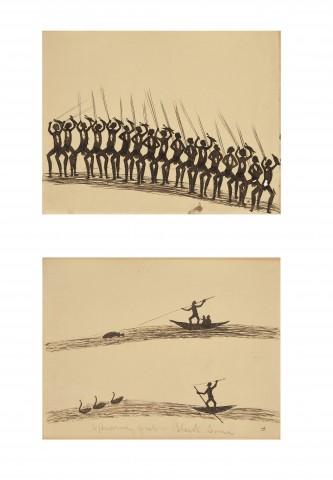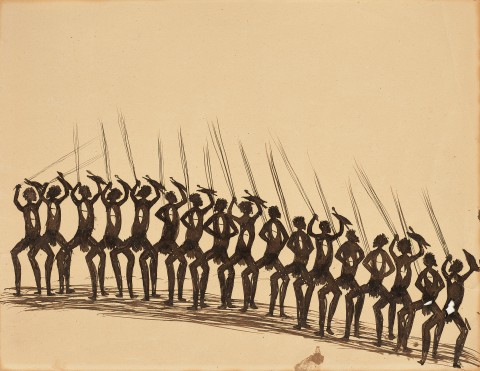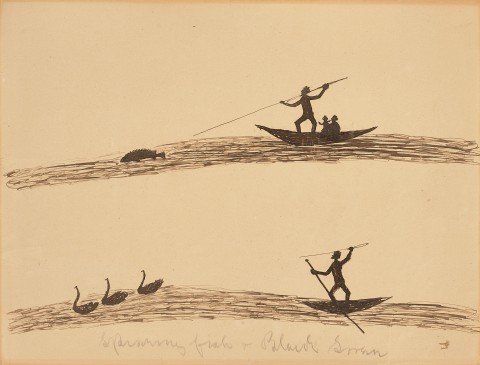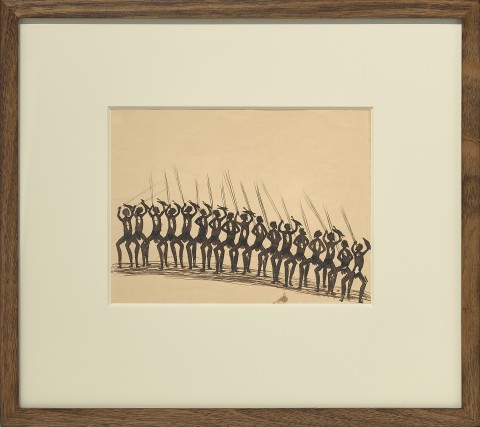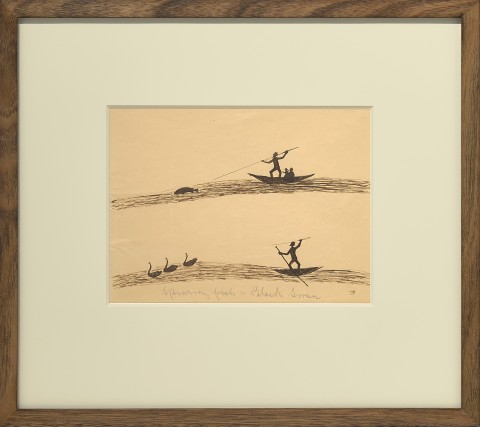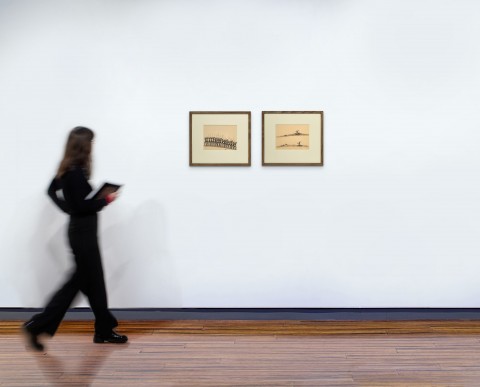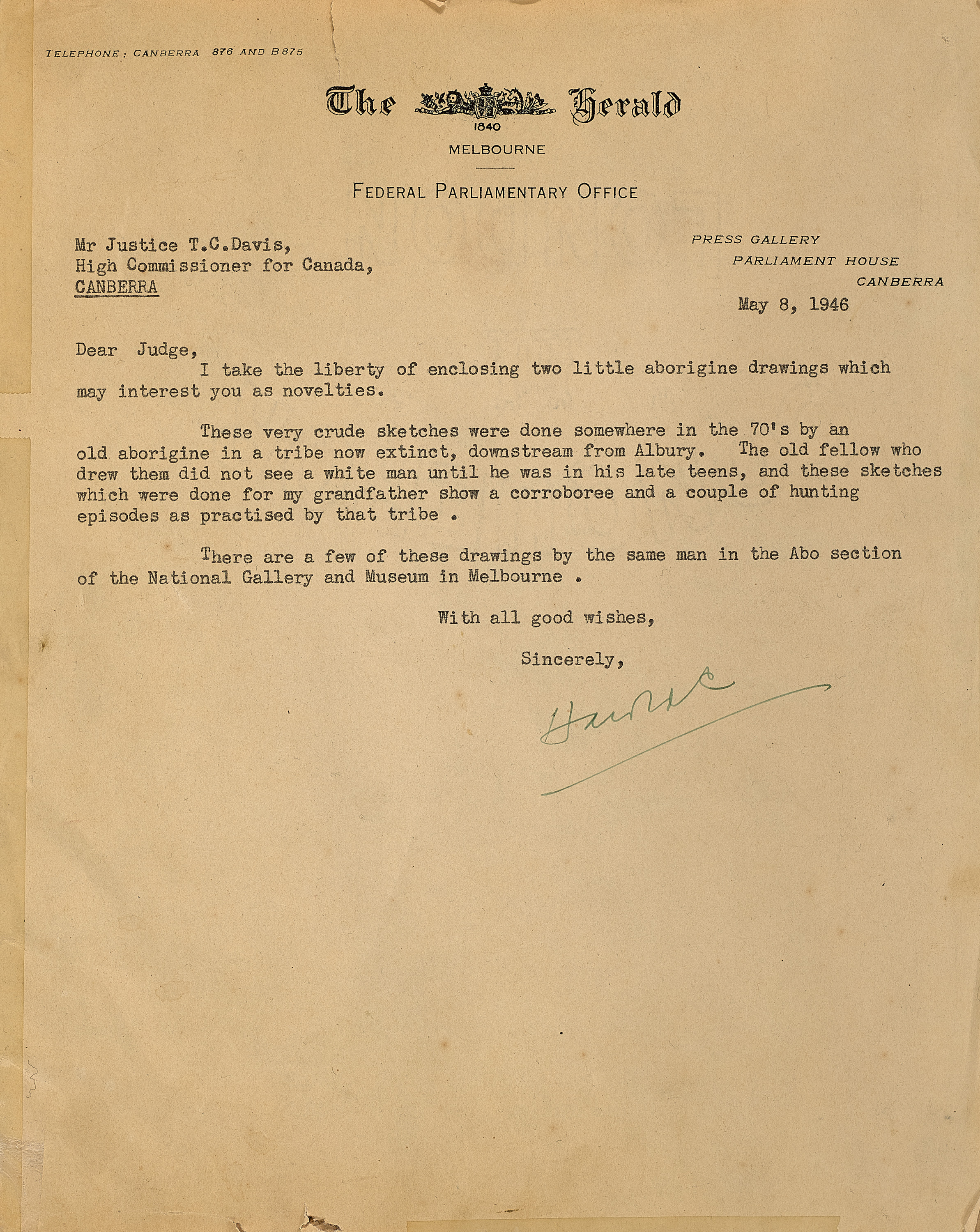(I) CEREMONY, c.1880
TOMMY MCRAE
(II) SPEARING FISH AND BLACK SWAN, c.1880
pen and ink on paper
22.0 x 28.0 cm (each)
ii. inscribed with title lower centre: Spearing fish and Black Swan
Roderick Kilborn, Wagunyah, acquired directly from the artist
Thence by descent
Harold Cox, Canberra
Mr Justice T. C. Davis, High Commissioner for Canada, Canberra, a gift from the above in May 1946
Thence by descent
Private collection, Canada
Frank Hall Estate Sales, Calgary, Canada, 16 April 2023, lot 313 (as ‘Artist Unknown’)
Private collection, Canada
(I) Ceremony, c.1891, pen and blue ink on paper, 24.5 x 31.0 cm, in the collection of the National Gallery of Victoria, Melbourne, illus. in Ryan, J., Indigenous Australian Art in The National Gallery of Victoria, National Gallery of Victoria, Melbourne, 2002, p. 11
(II) Spearing fish and swans from canoes, c.1895, pen and ink on paper, 24.8 x 31.5 cm, in the collection of the Latrobe Library, State Library of Victoria, Melbourne, illus. in Sayers, A., Aboriginal Artists of the Nineteenth Century, Oxford University Press, Melbourne, 1994, p. 37, pl. M13
We are grateful to Carol Cooper Shawcross for assistance with this catalogue entry.
Offering a rare insight into the Indigenous culture of the late 1800s and before, Tommy McRae's drawings are of great consequence as they are a valuable record of a local response to an increasing change of pace. McRae was a keen observer of the conduct of new settlers who surrounded him, and a man of deep reflection on the daily life and cultural activities of his own people. As Andrew Sayers observes, McRae had a 'keen sense of observation and a characteristic storytelling quality, often showing a wry amusement, [which] combine in his drawings to produce an evocative art, full of vitality'.1
A member of the southernmost part of the Wiradjuri nation, McRae (c.1836 – 1901) has been known variously as Yakanduna, Warra-uea, Tommy Barnes, and Tommy McRae. He was born in the Albury region and lived most of his life in the Upper Murray River area at Lake Moodemere, close to Wagunyah and Corowa on what is now the Victoria – New South Wales border. McRae worked as a stockman on surrounding local pastoral properties, and in his later life, began recording the daily events in his community and the newly settled towns. His depictions of traditional scenes of hunting, fishing and ceremony together with portrayal of European, and Chinese miners and historical events were, perhaps surprisingly, widely admired and supported by the local community. McRae's visual record was a rarity at this time of great change for the local Aboriginal population, with European settlers progressively colonising the land and appropriating its resources.
These two drawings were presented as a gift to Mr Justice T. C. Davis, the retiring High Commissioner for Canada at the completion of his term in May 1946, by Harold Cox, the the Melbourne Herald's Canberra Press Gallery journalist at the time who had inherited the works by descent from his grandfather, Roderick Kilborn. Both drawings record traditional aboriginal life. The subject of the first work, Ceremony, is one of McRae’s most frequent subjects and is perhaps a recollection of earlier experiences. Typical of McRae’s illustrations of these events, the ceremonial dancers are drawn in a row across the page from edge to edge in a frieze-like pattern. The dancers stand, legs wide apart, bent at the knees each interlocking with the next. All bear decorative body designs and hold a man’s hunting kit of spear, club and spearthrower. The integrated forms of the figures and the movement of the spears overhead create an effect of dancers moving in complete unison.
The second drawing records another of McRae’s preferred subjects, food gathering and hunting. Spearing Fish and Black Swan shows a hunter spearfishing from a bark canoe. Fish and birds were a stable part of the diet of the Indigenous people along the Murray River, consisting not only of Murray Cod (Maccullochella poeli) but also black swans and other waterbirds which were also hunted in this manner. These works tell a story, a pair of narratives of the hunt, one above the other, ‘his favourite motif is a scene where the prey is about to be captured – a moment pregnant with promise’2 and in both scenes, we observe the instant just before the hunter releases his spear.
The drawings of Tommy McRae as noted by Andrew Sayers are ‘distinct in their delicate use of the silhouette….. It is an art of extreme economy but for all its reductiveness, is highly expressive.’3 His figures are reduced to delicate outlines in the mostly blank space of the page with little surrounding detail, but with his simple use of gesture and movement, McRae’s drawings express all that is necessary to convey the story.
1. Sayers, A., Aboriginal Artists of the Nineteenth Century, Oxford University Press, Melbourne, 1994, p. 49
2. ibid., p. 36
3. ibid., p. 29
CRISPIN GUTTERIDGE
